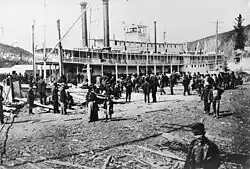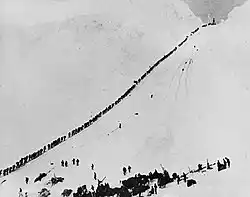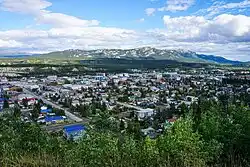
The Klondike Gold Rush, 1896–1899 was a gold rush which began in the early autumn of 1896 when gold when discovered in Rabbit Creek, a tributary of the bigger Klondike River in the Yukon area of north-western Canada, near the modern-day border with Alaska. When news of the discovery spread to cities like Vancouver, Toronto, Seattle and San Francisco it set off a gold fever which led to tens of thousands of people descending on what became Dawson City at Rabbit Creek. Over the space of the next few years approximately $29 million dollars’ worth of gold was pulled out of the river and surrounding region, a sum worth about one billion dollars in today’s money. Dawson City became a boom town briefly, peaking at about 20,000 people. Then, as quickly as it had begun, it was all over. In 1899 the amount of gold being retrieved declined significantly and thousands of prospectors and others left Dawson to head to new gold rush towns that were popping up around western Canada and in Alaska. The Klondike Gold Rush was the basis for a significant amount of settlement in Yukon and tangentially in British Columbia and many people in western Canada today might be able to trace their ancestors’ arrival here to the gold rush.[1]
Klondike Gold Rush chronology of eventsKlondike Gold Rush chronology of events
Like the United States, at the dawn of the nineteenth century, the west of Canada was quite thinly populated. In some places, there were few people other than the relatively small number of natives who lived here. This began to change as people spread out to the west coast and established fishing settlements and the like here from the mid-nineteenth century. However, the far north in the Yukon region was so cold and inhospitable that even as people spread out across North America from the 1850s onwards, few ventured this far north. That is until the Klondike Gold Rush began.[2]
Gold was struck in Rabbit Creek, a tributary of the Klondike River in mid-August 1896 by a handful of prospectors who lived in the small settlement of Dawson. At the time this was little more than a camp of hardy tent-dwellers. It would soon change. In 1897 a small fortune in gold arrived to Seattle and San Francisco with prospectors from Yukon newly arrived on ships from the north. As news of what had been discovered spread, tens of thousands of prospectors and people who felt they could prosper by going north to provide services at Dawson to the prospectors began boarding ships to head north.[3]
After a difficult journey many began arriving to Dawson late in 1897. Over the next year the settlement expanded into a real town with permanent buildings and lots of services for the newcomers. There was more than enough money to go around. In the late 1890s and into the early 1900s approximately $29 million dollars’ worth of gold was discovered, much of it panned in the river and more dug out of the surrounding lands. Yet it was all short-lived. By 1899 the amount of gold being found was declining precipitously and news was arriving to Dawson City of new gold finds at Nome in Alaska and at Atlin in British Columbia. With this people began abandoning the harsh environment of Yukon. Gold continued to be found there into the 1900s and is still to some extent even today, but the major flood of gold existed during a very small period of time between 1896 and 1899.[4]
Extent of migration associated with the Klondike Gold RushExtent of migration associated with the Klondike Gold Rush

The gold rush led to approximately 100,000 people boarding ships in cities like Vancouver, Seattle and San Francisco in 1897, 1898 and 1899 to sail north to the coast of north-western Canada before trekking overland to Dawson City. Of these, it is understood that only somewhere between 30,000 and 40,000 ever made it to the Klondike River to begin prospecting and engaging in service industries there. The rest abandoned the journey after realizing how difficult the conditions were in a part of the world where it is often consistently freezing and nighttime can last twenty hours a day at certain times of the year. Many suffered frostbite while trying to traverse Chilkoot Pass in the Coast Mountains and some people died from the conditions. Nevertheless, this constituted by far and away the largest influx of non-native settlers into the Yukon region up to that point.[5]
Demographic impact of the Klondike Gold RushDemographic impact of the Klondike Gold Rush

A considerable amount of the migration that occurred during the Klondike Gold Rush was transient. For instance, Dawson City, the epicenter of the settlement in western Canada associated with the gold rush, might have swelled to a town of tens of thousands of people at the height of events there in the late 1890s, but today it is little more than a village of about 1,500 people. Once the gold dried up, the people left. Conversely, there was a larger demographic impact on western Canada as a whole. Simply put, the gold rush accelerated the westward expansion of Canada and the opening up of the Yukon region to more general settlement. As such, many of the nearly 30,000 people who live in the town of Whitehorse to the south of Dawson City and other small towns in the area will be able to trace their ancestors back to people who arrived to north-western Canada in search of gold in the late 1890s.[6]
Others may well have left Dawson City and the Klondike area once the gold rush ended, but some of these would have settled further to the south afterwards in a more temperate climate and a region where land was plentiful. This led to a substantial spike in the population of British Columbia, the province south of Yukon, around the turn of the century. The population here was slightly over 90,000 in 1890. It nearly doubled to 175,000 by 1900 and then swelled to 392,000 by 1911 and over half a million by 1920. This wider settlement of western Canada was partially a byproduct of the Klondike Gold Rush.[7] A much more regrettable byproduct of this was the complete disruption of the way of life of the Han natives who had called the Yukon region their home for centuries. They were subsequently corralled onto the Moosehide Reserve.[8]
See alsoSee also
Explore more about the Klondike Gold RushExplore more about the Klondike Gold Rush
- 1901 Canada Census record collection on MyHeritage
- Canada, Burials, 1800-2019 record collection on MyHeritage
- Gold! Gold! Gold! The 1897 Klondike Rush at Legacy Family Tree Webinars
- How to Find Birth, Marriage and Death Registrations in Canada at Legacy Family Tree Webinars
- Genealogical Gold in British Columbia at Legacy Family Tree Webinars
References
- ↑ https://www.thecanadianencyclopedia.ca/en/article/klondike-gold-rush
- ↑ https://pier21.ca/research/immigration-history/settling-west-immigration-to-prairies
- ↑ https://www.history.com/topics/19th-century/klondike-gold-rush
- ↑ https://www.thecanadianencyclopedia.ca/en/article/gold-rushes
- ↑ https://www.nps.gov/klgo/learn/goldrush.htm
- ↑ https://www.thecanadianencyclopedia.ca/en/article/whitehorse
- ↑ https://www12.statcan.gc.ca/census-recensement/index-eng.cfm
- ↑ https://www.thecanadianencyclopedia.ca/en/article/han

